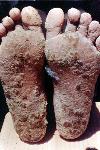|

|
|
|
|

|
 |
|
|
|
Natural
sources
 |
The average arsenic concentration in earth crust is 2 ppm
but it can be much more concentrated in arsenic-containing ores such as arsenopyrite
(FeAsS) or orpiment (As4S6). Concentrations as high as 20000 ppm can
be found in these materials.
In soils, there is important differences in concentration values mainly due to the nature
of the rock present in the soil. Concentrations as high as 8000 ppm have been reported.
In water, the arsenic occurrence is linked to the nature of soil and rock. For instance in
a gold mining water, the concentration can reach 1g/L but in sea water the concentration
is between 2 and 14 ppb.
Most of studies have reported high concentrations in some well water (1 ppm) due again to
the presence of rich arsenic rock close to the groundwater.
In the air, more of arsenic is present as tiny particles. One of a important natural
source is the volcanoes activity. |
|
|
|
|
Arsenic emission due to human activities
 |
Arsenic is currently used in
some industrial facilities because of its interesting properties regarding
microelectronic, glass, alloy, weed killer or pharmaceuticals.
By this way it is used as wood preservative in the form of Copper Arsenate. It is also
used as defoliant and pesticide.
It is also found as an ingredient in pigments such as Paris Green Cu(CH3COO)2,
3Cu(AsO2)2) or Scheele Green (Cu(AsO2)2).
Since few years much attention is paid on the properties of Gallium Arsenide (GaAs). In
fact this semi-conductor is prefered to Si based components in mobile phones
Arsenic is used in glass industry for the manucfacturing of "opalescent
glasses". This kind of glass is made of 66 % of sand, 3 % PbO, 3 % PO5 and between
0,19 to 0,66 % of AsO3 (http://www.glass.co.nz/opalesc.htm. |
|
|
|
|
Arsenic toxicity
 |
Obviously arsenic is a poisonous
element known since many years. However its mechanism of toxicity is not clearly
established.
Degrees of toxicity: As (III) > As (V) > Organic arsenic compounds.
At the present time arsenic poisoning threathen 40 millions people in Bangladesh due to
its release from arsenic-rich minerals in contact with groundwater , the main source of
drinking water. |
|
| |
|
 |
Skin damage of slow arsenic poisoning in one
Bangladesh victim |
|
|
|
Visit
these links to know more about arsenic contamination in Bangladesh
|